by Heather Plett | Nov 12, 2015 | connection, criticism, fearless, holding space, journey

“I’m trying not to take it personally, but…” Those are the opening words to many stories I hear from my coaching clients. They’re usually sharing something that has been spiralling through their mind – something that caused a wound, brought up fear, or blocked them from doing something they really wanted to do. They’re not only taking it personally, they’re carrying shame that they can’t simply brush it off.
My response to them is always the same.
Go ahead and take it personally.
Allow yourself to feel the hurt. Allow yourself to cry. Allow yourself to be angry, fearful, frustrated, sad, wounded, etc. Don’t shut down the feelings because of some ancient script that’s telling you that you’re weak if you take things personally.
Do not be ashamed of being a big-hearted, big-feeling person.
I’m not suggesting you should get stuck there, but that’s a good place to start. Healing starts in a heart that’s open, a heart that’s not afraid to feel, a heart that doesn’t try to stuff things away.
I often takes things personally. And I am no longer ashamed of that fact.
As my work becomes more and more public, I occasionally (though thankfully not frequently), get emails criticizing something I’ve said or done or not said or not done on my blog, in my courses, etc.. I used to tell myself “brush it off – this comes with the territory”. But that kind of self-talk was never helpful. I realized that, in trying to stuff the wound away, I was short-circuiting my ability to grow and learn from the wound.
When we bury the wound, we deny it the opportunity to teach us something.
Now, when an email or comment wounds me, the first thing I do is step away from the computer and find a cozy place where I can feel what I need to feel. I might make myself a cup of tea, wrap myself in my favourite blanket or prayer shawl, or head out to the woods where the trees don’t judge me for crying.
The second thing I do is to grab my journal. Journal writing (and mandala-journaling) has always been my way of processing the world. I sit down, and start writing all of the feelings – the hurt, the shame, the anger, the unworthiness, etc.. I don’t censor myself. I just let the pain show up on the page. Sometimes that’s all I need. The simple act of releasing it onto the page can be enough to shift how I feel about it.
If I need more work on it, I let my pen expand my heart as I stretch myself beyond the pain into the learning. I ask myself a few questions and try to answer them as honestly as possible:
- Why is this triggering me? What old stories is it bringing up? (ie. Do I have stories of unworthiness, failure, shame, etc.?)
- What is the deeper healing this wound is inviting me to?
- What truth, even though it’s painful, do I need to receive from what’s been said and what do I need to change as a result?
- Which parts of what’s been said do I need to let go of, recognizing that whatever’s been said is rooted in the other person’s stories, fears, etc.?
- What new stories and new courage might this experience help me step into?
If things still feel unresolved after the journaling, walking, tea-drinking, crying, etc., I consult a trusted friend who will hold space for me while I talk my way through it. The right friend will help me gain perspective on it by asking good questions and offering other ways of interpreting it. She/he will never judge me for feeling the way I feel. (The ones who do make us feel judged are not the right friends to trust at that time.)
After I’ve done my personal work and talked with a friend, I do some discernment about what kind of response is required of me. My response usually depends on the relationship.
If it’s someone with whom I have an ongoing relationship that I want to maintain, I will invest time and energy in trying to engage in a meaningful conversation that will help us both move past this wound. I try to be as honest as possible in admitting how it made me feel (and maybe why it made me feel that way), receiving what I think is valuable in the criticism, and then expressing which part I don’t think is mine to carry forward (releasing, not blaming). I might also ask them to further explain their perspective, if I need deeper understanding.
I love what Brene Brown says in Rising Strong about engaging someone in a conversation after you’ve felt wounded by them. Instead of laying blame, she starts with “the story I’m making up is…” In other words, “I admit to interpreting this through the lens of my own past hurts, self-esteem, etc., and I want to give you a chance to offer a different story if I misinterpreted.”
If the email that hurt me is from a stranger with whom I have no relationship, I decide whether it’s worth it or not to invest in a reply. (Some people are simply complainers or trolls who have earned no right to that amount of my energy.) If it’s worth investing in, I usually respond with a much shorter email (remembering that I don’t have to over-explain myself), expressing gratitude for whatever I gained in the exchange and releasing what isn’t mine to carry. I may or may not invite them to engage further, depending on how much it’s worth to me.
Doing this kind of work when I feel wounded isn’t easy, but it’s necessary if I want to continue to grow and be in healthy relationships with people.
The best thing is that each time I do the work, it heals me a little more and makes me stronger for the next time I face something that has the potential to wound me. Some of the things that wounded me ten years ago no longer have that kind of power over me because I did the work to heal them. And some of the things that wound me now will no longer have power over me in ten years. That’s what doing my personal work healing is all about. It’s never over – it just goes deeper.
“You can’t get to courage without walking through vulnerability. You can choose comfort or you can choose courage. You can’t choose both. Courage is uncomfortable. That is why it’s rare. Being courageous is more important to me, as a value, than succeeding.” ~ Brené Brown
Interested in more articles like this? Add your name to my email list and you’ll receive a free ebook, A Path to Connection. I send out weekly newsletters and updates on my work.
by Heather Plett | Oct 28, 2015 | growth, journey
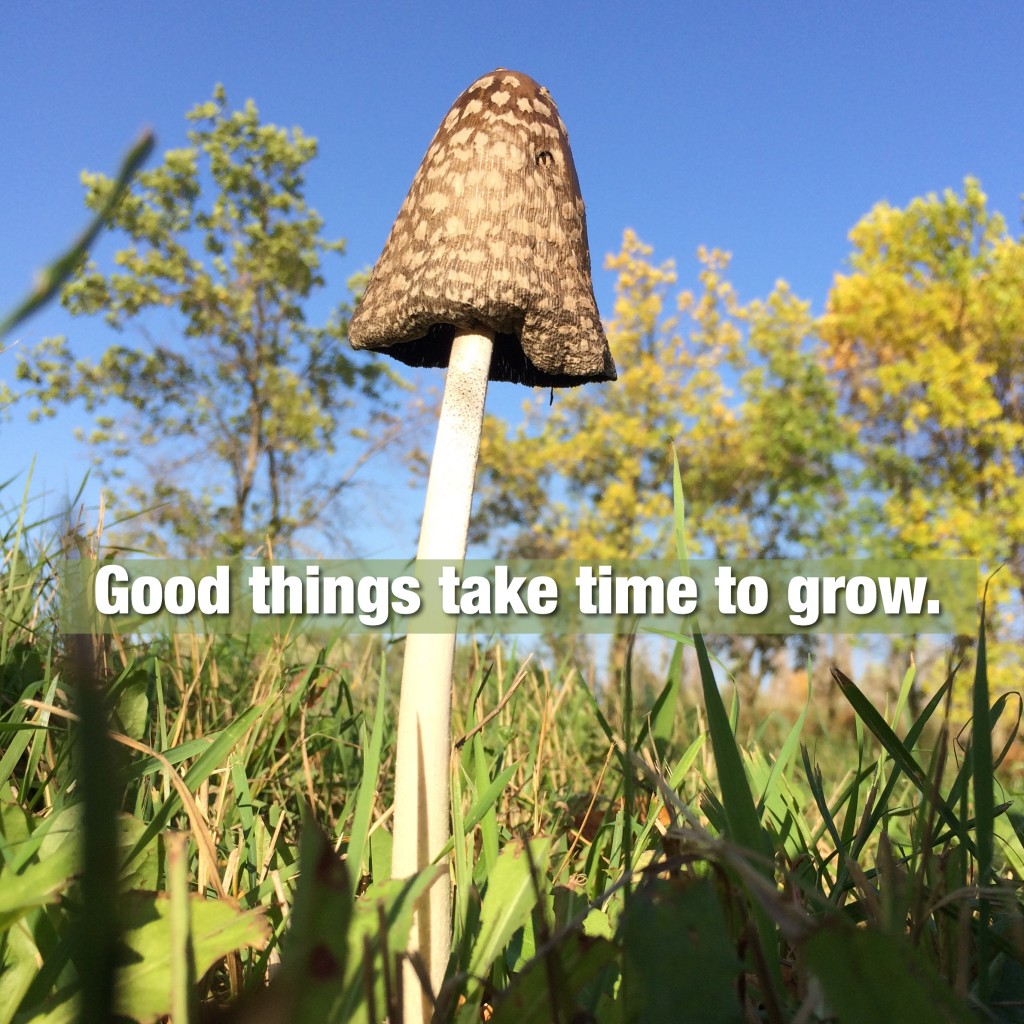
Every week, I have the privilege of talking to coaching clients who are learning to tell the truth. They sit in front of me, on Skype or sometimes in person, and they speak the most tender words about what they really believe, what they really want to spend their time doing, or what they are longing to walk away from. Often, I have the honour of being the first person to hear these tender new truths.
I applaud every one of these truth-tellers. They are courageous in their desire to be authentic and in their willingness to be witnessed by at least one person.
It doesn’t matter to me how long it’s taken them to get to this place, or how long it will take them to speak it to an audience larger than one – I only care that they are here now and that they are saying it out loud, that they are daring to whisper what their hearts have been nudging them to speak. Always, they have walked through fear and sometimes through fire before coming to this place.
We hold those tender truths in front of us while we talk. We admire them, like tiny green shoots emerging after the Spring thaw. We caress them and encourage them and wish them heaps of blessings as they begin to make their way in the world.
Sometimes my clients are launching new businesses, sometimes they’re learning to share their stories with the world, sometimes they’re finding the courage to teach what has long been growing in their hearts, and sometimes they’re stepping onto new spiritual journeys unlike what they’ve embraced in the past. There are differences in what they share with me, what they want me to help them with, and what they’re transitioning into, but there are also many similarities.
The similarities are these: they are trying to find the courage to live more authentically, they are seeking a witness who will hold space for them and help them see more clearly, they are admitting that something about their old way of walking in the world no longer fits what is emerging in them, and they are facing resistance (whether external, internal, or both) that tells them they should stay safe.
But these are not people who are comfortable with staying safe, or they wouldn’t have hired me. The very act of reaching out for someone to witness them and help them find clarity was an act of courage. These are people who know they can no longer live with the status quo.
For most of these people, though, it takes a long, long time to get to the place where they are ready to hire a coach and do the hard work of articulating and growing whatever beautiful, tender green shoot they’re holding. Some clients are in their sixties, seventies, or even eighties, and though they sometimes worry that it’s too late to embrace a new way of living, they know they can’t be satisfied with the old comforts anymore.
And that, dear reader, brings me to what I want to say to you…
It doesn’t matter how long it takes. It only matters that you don’t ignore whatever is whispering in your heart.
Give it as much space as you can right now and forgive yourself for what you just can’t do yet. This is not a race.
Sometimes it takes a long time because you’re afraid a change in you will hurt the people near and dear to you. Sometimes it’s because you are busy raising children and you are too exhausted to do anything else. Sometimes the whispering is frighteningly counter-cultural and you know the risk of trusting it is just too overwhelming right now. Sometimes you first need to extricate yourself from a bad relationship before you can dedicate time to your own growth. Or sometimes you find yourself in the kind of financial or emotional distress that just doesn’t leave any energy for truth-telling.
It’s not hard to find coaches or teachers who would give you “easy” answers for all of those things that get in the way, but none of that is truly easy and nobody else can know the challenge of your reality. Only you know what is holding you back and only you know when you are ready for the next step. Only you know the depth of your own fear or trauma or old baggage.
Good things take time to grow. Some bamboo plants grow roots for four years before anything begins to emerge above ground. You don’t need to rush it and you don’t need to take on anyone else’s story of what you should be capable of right now.
Just take the baby steps you can take right now.
In the early days of my own emergence, when I was employed in a government job and raising small children and thought it was taking far too long to find the path I knew was searching for, I wrote many tender thoughts and ideas in my journal. For years, that was the only place those ideas found a home. I dared not speak what I didn’t fully understand yet and what didn’t fit with what was expected of me. It took several years before I started to find like-minded people to whom I could tentatively speak of that which I longed for. At first, there were only a few trusted people, and gradually, as I felt more and more safe, the circles grew. With each growth of the circles, I had to work through a new level of fear and practice stepping into a new level of courage.
These things don’t happen overnight. There is a lot of learning to do along the way and a lot of tiny acts of courage that take more energy than we expect. This is even more true if the growth includes healing from past trauma and/or grief, as it does for many of us.
Give yourself time. Take the step you are ready to take, and then when the time is right, you’ll take the one after that.
by Heather Plett | Aug 26, 2015 | childhood, growth, parenting
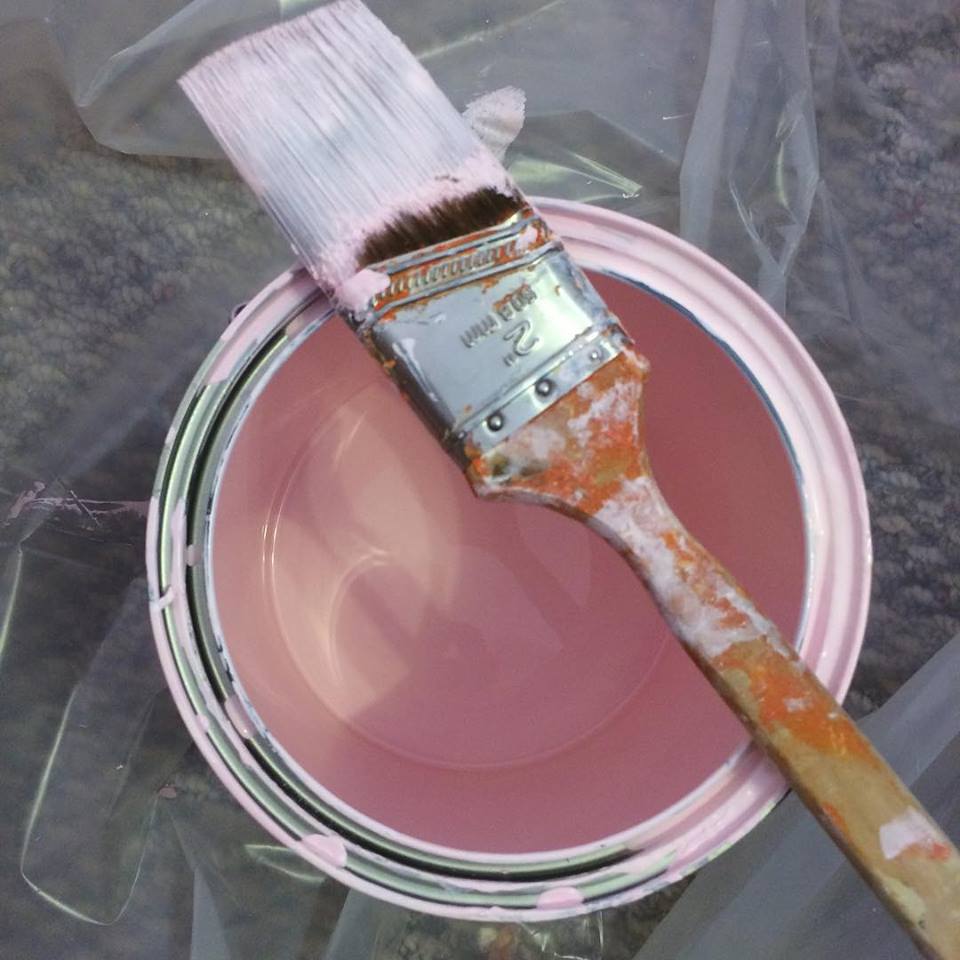
It all started in Maddy’s room. She’d been complaining for quite some time that she’d had to inherit a room decorated for her sisters when they were quite young and it was time for her to have a room fit for her own thirteen-year-old personality. After waffling between a Harry Potter themed room and pretty-in-pink, she chose a pale pink and we bought the paint. It made me smile when I applied it, because it was the exact opposite of what had happened when I was that age. I couldn’t wait to get rid of the pink in the little-girl bedroom I shared with my sister. In my mind, pink = girlie and girlie wasn’t cool, so the bedroom was painted blue.
Like many in my era, I was figuring out who I was in the face of the feminist movement, and instead of embracing what was feminine, I ran away from it and tried to prove I was worthy by being more masculine. It wasn’t until years later that I realized that a) pink is just a colour and has no inherent meaning, and b) to be whole and strong means to embrace what is feminine along with what is masculine.
The day we were choosing the paint, I overhead Maddy (who wears nothing but dresses) say to her friend, “Legally Blonde is my favourite movie because it shows that you can be both feminine and feminist at the same time.” I’m so glad she’s figuring that out earlier than I did.
My other two daughters are now 18 and 19 and though they’ll both be in university in the Fall, they’ll be staying home and studying locally for now. They were switching bedrooms (it was the 18 year old’s turn to have the bigger room in the basement), so it seemed like the ideal time to refresh their rooms as well.
In both cases, we transformed the rooms from their early-teen choices to their much more grown-up choices. The room in the basement (that had been Nikki’s and was becoming Julie’s) was four bright colours – blue, green, orange and yellow – and was now getting a much more subdued look – black, grey, and light teal-grey. The room upstairs was going from orange and green with huge contrasting polka-dots to a dark beige and white.
Julie’s former orange and green room presented us with the greatest challenge, not because of the boldness of the colours but because she had covered the walls with hundreds of quotes, thoughts, art, etc., in Sharpie marker.
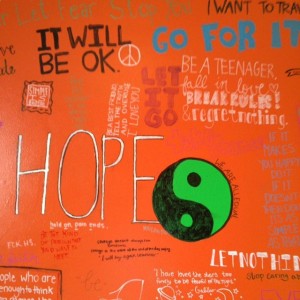 I knew from previous experience that Sharpie marker is almost impossible to cover with paint, even with the very best primer, and yet, five years ago, when she’d asked if she could do it, I said yes. Julie has a gift for script-work and I knew it would be interesting, but more importantly, I had an intuitive sense that it was what she needed at the time.
I knew from previous experience that Sharpie marker is almost impossible to cover with paint, even with the very best primer, and yet, five years ago, when she’d asked if she could do it, I said yes. Julie has a gift for script-work and I knew it would be interesting, but more importantly, I had an intuitive sense that it was what she needed at the time.
The hardest year of Julie’s life so far was when she was thirteen and in grade 8. She’s a deep thinker and a deep feeler, and the world was too intense for her at the time. We watched her walk through a depression and we worried every single day about whether we were doing the right things to support her. When she started writing on the walls, I bought the Sharpie markers, hoping that turning her bedroom walls into a journal of her angst and attempts to rise out of that angst might be healing for her. It was.
Some of what was on the walls was quite angry (especially what she hid in the closet), some was quite hopeful, and all of it was a search for her own path and for meaning in a complex world. Like, for example, the giant word “HOPE” with the smaller words underneath “hold on pain ends”.
While we painted over the Sharpie markings last week, Julie thanked me for letting her do it. On an Instagram photo she posted, she said this: “Incredibly thankful to have the kind of parents who let their angsty 13 year old daughter put her art all over her walls, even if it involves buying $70 primer to cover it up 5 years later.”
Like any parent, I had no idea if we were doing the right thing at the time, and yet we did what we could. And now she has grown into a strong, articulate and wise 18 year old who was class valedictorian at her recent graduation and who won a scholarship for being a gifted writer. (Here’s a piece of her writing I once shared on my blog.)
A few insights emerged while I painted the walls last week, not just about parenting but about holding space for anyone going through their own personal growth. Parenting three daughters who each have unique (and surprisingly different) personalities is a great training ground for my coaching and facilitation work.
Here’s what I’m learning about holding space for people in the midst of their own personal growth:
1) Respect each person as an individual. No two people need exactly the same things at the same time. My other 2 daughters never wrote on the walls, but they need other things, and so we try to offer them what they need to help them through the rough spots. When I try to treat them all the same, I do them a disservice. For example, one is an introvert, one’s an extrovert and one is somewhere in between. They’re learning to recognize what they each need in order to replenish their energy.
2) Honour whatever place a person is in their own journey. Don’t expect someone else’s journey to look anything like yours. All three bedrooms are completely different from what they were and all of them reflect the places the girls are in right now (not five years ago and not five years in the future). There are choices in each bedroom that are different from the choices I might have made, but I’m not the ones occupying those spaces.
3.) Help people find their own right creative practices. During Julie’s depression, I tried to get her to do some of the things that help me through the darkness, but none of those things were right for her. I couldn’t take that personally because it wasn’t about me – it was about her. What worked for her was Sharpie markers and permission to make art on the walls.
4.) Don’t be afraid to let others take risks you wouldn’t take. I often marvel at how confidently Maddy embraces dresses and the colour pink. (At the same time, she also considered black skull-and-crossbone curtains – she is far from one-dimensional.) None of her friends wear dresses and I doubt whether any of them would choose the colour of paint she chose, and yet it’s what she likes and that’s all that matters.
5.) Give people a safe place to hide, to be themselves, to fail, or separate themselves from others. I am so glad that I had the privilege of giving each of my girls a beautiful new space to call their own. They are all learning to honour their own choices, their own sense of when they need to withdraw from the world, and their own boundaries. Those are powerful things to learn, especially for teenage girls navigating a world that places far too many expectations on them. Nikki, my most introverted daughter, loves to close the door to her room and listen to her record player alone, while her more extraverted sisters have been happy to invite friends over to enjoy their rooms with them.
I don’t often write posts about my daughters or about parenting, because their stories are their own and because most days I feel like I’m wandering around in the dark trying to feel my way through. But my parenting journey has taught me much about what it means to hold space for people on their own personal growth paths and I know that I am a better coach and facilitator for the lessons I’ve learned along the way. I can only hope that my daughters will continue to grow into strong, resilient, and courageous young women.
by Heather Plett | Jul 25, 2015 | connection, growth, journey
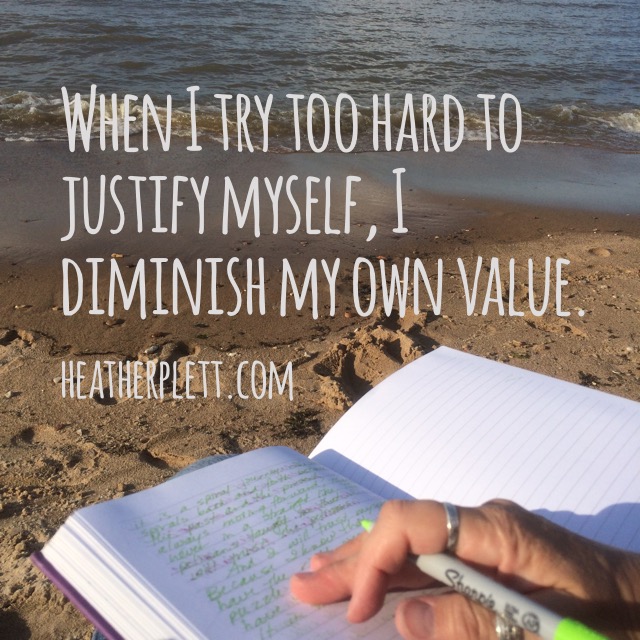 Three years ago, I finished writing a memoir. After more than a year of hard work, I was pretty sure it just needed the eyes of an editor to find the spelling errors and smooth out the rough spots. I started working on getting it published.
Three years ago, I finished writing a memoir. After more than a year of hard work, I was pretty sure it just needed the eyes of an editor to find the spelling errors and smooth out the rough spots. I started working on getting it published.
But then, life got in the way. My Mom’s cancer came back with a vengeance, and soon she was slipping away from us. Losing her knocked the wind out of me and I had nothing to give to the book.
Last year, I went back to the book, but it held very little energy for me anymore. The loss of mom had changed the end of the story, and when I read through it again, I knew that there were big sections of it that needed re-writing. Several times, I tried to revisit it, and once or twice thought I was finally getting back into the groove, but in the end, it always fell flat and I abandoned it. There was something missing and some parts that simply didn’t flow.
Earlier this year, I decided I’d take the book to the Self as Source of the Story writing retreat on Whidbey Island. I told myself that if I found any inspiration to bring it back to life, I’d stick with it, but if not, I’d finally let it die.
Almost as soon as I got there, life was breathed back into it. A new and intriguing voice emerged that wanted to be heard in the story, and it was instantly clear that that’s what had been missing from the first version. As Christina Baldwin says, “I wrote like heaven.”
When I came home, though, it was harder to find that voice again and I worried that it was only something I could tap into in the magical retreat centre on Whidbey Island. With end-of-school activities consuming much of my attention, I let the book rest for awhile.
And then one day I had the inspiration to ask my friend Louise about the availability of her cottage. Perhaps if I secluded myself in a cottage by the lake for a week the new voice and the energy to complete the book would return. I was right. For five days, I again wrote like heaven.
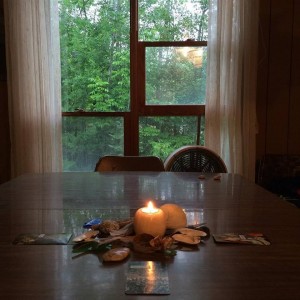
where I wrote for 5 days
At the end of the week, when I’d finished weaving the new voice in with the old, I started the painstaking work of going through it all page by page, trying to find the weak spots. As I did so, I bumped up against some of the old resistance that showed up last year. Suddenly, I doubted whether the book was any good. There were still large sections of it that didn’t flow well and I wasn’t sure it was worth trying to fix them.
I did the only thing I knew to do – I stood up from my computer and went for a long walk on the beach. Somewhere in the middle of the walk, after finding treasures on the beach and watching pelicans float in spirals across the sky, I knew what I had to do. I had to be ruthless and chop out the pieces that didn’t work.
I went back to my computer and started chopping. Anything that felt awkward or that didn’t fit with the new rhythm of the book disappeared into the ether. Almost 10,000 words disappeared in short order and it felt surprisingly good.
Halfway through that process I realized that the pieces being chopped had something in common.
I was cutting out every piece where I tried too hard to explain myself.
I wasn’t letting the story speak for itself. Instead, I was interjecting, offering ways for the reader to understand the story. In doing so, I was not only dragging down the flow of the story, but I was treating the reader like he or she wasn’t smart enough to weave together the threads and draw his or her own conclusion. Most importantly, I was treating the story like it didn’t have enough merit to stand on its own without explanation.
It suddenly occurred to me that what I was doing when I wrote the first draft of the book is the same thing I do in my life – I over-explain myself. This summer, for example, I decided that I wasn’t going to take any new coaching clients. Each time someone writes asking me to coach them, I feel badly about saying no and I feel a need to justify myself. I do the same when I’m teaching and I have to make an unpopular decision – I over-explain it to the students instead of simply saying “this is my decision”. And I do it in my relationships too. If I’m tired and don’t want to pick up one of my daughters from work, I feel compelled to give her an explanation.
What am I doing when I over-explain myself? I’m diminishing my own value. I’m treating myself like I don’t have a right to make these decisions unless I have a good reason to justify them. I’m letting other people’s stories be more important than my own. And I’m giving in to the fear that I might be rejected if I don’t have a good enough reason for my choice.
When I made that realization, a little snippet of a Bible verse came back to me… “Let your yes be yes and your no be no.”
I’m not sure what the writer’s intent was when he wrote that passage, but I know what it now means for me.
If you’ve made a decision from a place of integrity, there is no need to justify it to anyone.
Don’t diminish the value of your own story by over-explaining it.
Don’t treat yourself like you don’t have the right to make a decision a certain way by over-explaining your reason for it.
When I cut out those 10,000 words of explanation, I knew right away that the book was stronger and easier to read. The story can stand on its own merit. Too much explanation takes away from the poetry of it.
The same is true when I cut out the over-explaining from my vocabulary. My choices can stand on their own merit. Too much explanation diminishes my strength and questions my value.
Let your yes be yes and your no be no.
Do you want to learn to write from an open heart? The next Openhearted Writing Circle is on September 18th and it’s online so anyone with a computer can join!
Looking for a self-discovery practice that will help you learn to trust yourself more? Mandala Discovery starts on August 1st.
Interested in more articles like this? Add your name to my email list and you’ll receive a free ebook, A Path to Connection. I send out weekly newsletters and updates on my work.
by Heather Plett | Jan 22, 2015 | beauty, Wisdom, women
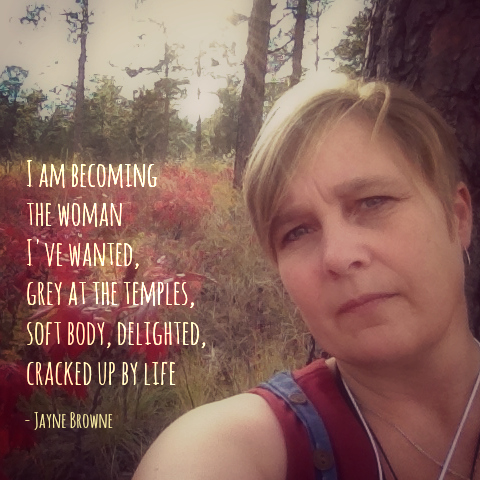
Last night I hosted a circle of women on Skype, and at the beginning of the call I read this poem:
Finding her here
by Jayne Brown
I am becoming the woman I’ve wanted,
grey at the temples,
soft body, delighted,
cracked up by life
with a laugh that’s known bitter
but, past it, got better,
knows she’s a survivor–
that whatever comes,
she can outlast it.
I am becoming a deep
weathered basket.
I am becoming the woman I’ve longed for,
the motherly lover
with arms strong and tender,
the growing up daughter
who blushes surprises.
I am becoming full moons
and sunrises.
I find her becoming,
this woman I’ve wanted,
who knows she’ll encompass,
who knows she’s sufficient,
knows where she’s going
and travels with passion.
Who remembers she’s precious,
but knows she’s not scarce–
who knows she is plenty,
plenty to share.
After the poem, I asked each woman to share something about the woman they are becoming. Some shared that they are becoming more confident, more open, more authentic, and more self-aware. Some are becoming leaders, spiritual guides, teachers, and wise grandmothers.
Several of the women remarked on the line “I am becoming a deep weathered basket.” They resonated with the image – becoming a vessel of whatever they’re called to carry, a little worn, beat up, and perhaps leaking, but still full of gift. The older women on the call focused on the world “weathered”, while one of the younger women said she was grateful for all that leaked out of those weathered baskets into her own, much less seasoned, basket.
When it was my turn to hold the virtual talking piece, my first top-of-mind response was “Satisfied. I am becoming more satisfied.”
I am becoming more satisfied that I am enough. I am becoming more satisfied that I have enough. I am becoming more satisfied that the work that I do is the right work and that I am living as authentically as I can. I am becoming more satisfied that I’m doing the best I can as a mother.
That thought surprised me, given the kind of day and month I’d had, but it popped out of my mouth and after I said it I knew that it was true.
Earlier that day, when one of my daughters had a crisis, I was worried that I hadn’t provided her with enough tools to weather the emotional storms when they come.
Earlier that month, when online sales were flat-lining and a class I was supposed to teach at university got canceled, I was worried that I wasn’t doing a good enough job in growing my business.
And yet, despite those worries, despite the fact that I am still full of human weakness – I still feel the jealousy well up when I see others with more success than me, I still suffer from insecurity when I think I’m not parenting well, I still get unreasonably angry when my husband doesn’t do something I expected him to do – I am becoming more satisfied.
I am not becoming more perfect. I’m not even sure, sometimes, that I’m becoming more wise. My questions increasingly outweigh my answers. But I am becoming more satisfied.
I won’t always parent well. I won’t always say the right things when I teach. I won’t always be successful in my business. My skin is becoming increasingly more saggy and my belly – well, it will never be as flat as I’d like.
BUT I’m learning to love myself more, I’m learning to forgive myself faster, I’m learning to trust that I’ll have the wisdom I need to get through the challenges, and that’s good enough.
With each disappointment, each challenge, each heartbreak, and each victory, I become more authentic, more satisfied, and more committed to being fully myself. As the poem says, I am becoming the woman “who knows she is plenty, plenty to share.”
Now it’s your turn… “Who are you becoming?” Are you satisfied with the answer?
I invite you to join me on a journey that will bring you closer to the woman you are becoming. When you sign up for The Spiral Path, you’ll receive 21 lessons, full of stories, inspiration, journal questions, and embodiment exercises that are designed to bring you closer and closer to the core of who you are. For only $45, you’ll receive a whole lot of content that has the potential to change your life.
Here’s what one participant said before she’d even worked all of the way through: “I’ve worked thru Lesson 9….I have shed tears, felt my anger, and looked at my fears up close and in 3-D. I have felt the darkness, and feel brave and courageous about sitting with it. I now feel much more comfortable in my body and am ready to move ahead and receive all the gifts that will come as a result of this work.” (Carol Brown)
Please join me as we all become the women we’ve wanted.







